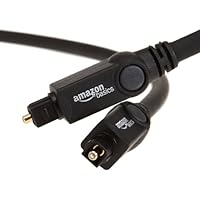
- Ships in Certified Frustration-Free Packaging
- One 6-foot-long (1.8 meters) TOSLINK digital audio optical cable
- Connects audio components to your audio or home theater system
- Constructed with durable, black PVC outer layer, and corrosion-resistant, gold-plated connectors for optimal signal transfer.
- Distributed by Amazon backed by one-year AmazonBasics warranty
The cable is high quality, long, and very flexible and has nicely constructed connectors. And it is about 1/4 the cost of radio sxxxx and bsst buy, both being rip-off artists on items like cables.
Its things like this that will make me a prime return customer. Who can't wait 2 days to save big bucks??
Buy AmazonBasics Digital Optical Audio Toslink Cable, 6 Feet Now
My goal in life is to never buy overpriced cables. I figure that it is a cable and how could it break. After all it just sits there collecting dust. It's a digital signal going through glass/plastic fiber, there will be no difference compared to the $450 dollar AudioQuest class 5 optical cable TosLink plugs 1m (3.28'). If you bought this $450 cable, I cry for you.The cable is your basic black color and it looks as nice as a cable can look. The cable is flexible and bendy just like a cable should be. It is long. The connection fits snugly from my Pioneer VSX-1019AH-K 7-Channel A/V Receiver (Black) to my ancient Philips DirecTV DVR With 40GB TIVO.
It comes in a nice cardboard box that is so simple to open. You can then toss the packaging into your recycle bin for recycling.
Read Best Reviews of AmazonBasics Digital Optical Audio Toslink Cable, 6 Feet Here
These cables are pretty awesome.Initial setup (who cares): The cable came in an easy to open cardboard box. The plastic tips needed to be removed but that hardly was an issue given I have opposable thumbs.
Sound quality: The quality of the sound was on par with some of the more expensive cables I've had previously. I didn't notice any interference and it sounded fairly clear.
In general there isn't too much to say about this product; either it works or it doesn't work. It works and I recommend it.
Want AmazonBasics Digital Optical Audio Toslink Cable, 6 Feet Discount?
1. Open the box.2. Remove the cable
3. Remove the twistie tie (counter-clockwise rotation is critical for success)
4. REMOVE THE PLASTIC NIBS covering the connectors
5. Plug one end into your TV optical port and the other end into the electronic device of your choice
6. Enjoy the show
These AmazonBasics cables are the cat's ass. I wish they came in shorter lengths (cable neat freak), but the price can't be beat. You won't be disappointed.Having owned an HDTV for quite a while now, I've always used the TV speakers because I've never owned a home theater system although all my friends and family have a home theater system. I've always relied on non-digital cabling to cable up my devices to the TV (with the exception of my devices that have HDMI ports). Anyone who is familiar with cabling knows that the majority of it are metal-based. Being metal means that it's subject to potential interference and with interference comes those higher dollar cables that include various methods to remove interference whether via shielding in the jacket or ferrite toroids. Not sure what that is? Just Google it.
For Christmas, my wife bought me a simple home theater system. It's not a four-figure home theater system but it's definitely an improvement over the standard TV speakers. While I was setting it up, I noticed that it supported several inputs/outputs, including optical audio, standard audio out via mini jack, HDMI, etc. Since I never owned a home theater system, I never owned an optical audio cable. When I tried to connect the system to all my components, I noticed that there was a "hum" that came out the speakers when nothing was playing. I narrowed it down to the dang mini jack cable (despite being a Monster cable) that connected to my home theater system. I removed that and the hum disappeared.
That's when I decided to buy the Amazon digital optical cable because I knew it would get rid of the hum interference. I 100% knew it would fix the situation because I deal with optical cabling on a daily basis in my job (Network Engineer). The benefits of optical cabling is that it's purely digital and that there is no "metal" that makes it more subject to interference. As long as the ends are clean (there are removable protective plastic caps to keep dirt/scratches from touch the ends), then you should be able to connect any device without problems. With digital, it either works or it doesn't. If this cable does not work on your device, it's either due to bad ports or a broken cable. Because of that nature, there is absolutely NO NEED to buy those overpriced cables from high end audio-video companies (like Monster). While Monster cables do help somewhat because of all the shielding they put in their product, it's unnecessary with digital optical cables. Therefore you can go with a cheaper cable (like this Amazon one) with a piece of mind knowing that it just works.
Of course I'm not saying buy the cheapest cable you can find. Name does matter to a degree (build quality of the cable). I've owned several different AmazonBasics cabling and can definitely say that this cable is professionally built and not "crappily" made. I'm very satisfied with this cable and my home theater is too.


0 comments:
Post a Comment